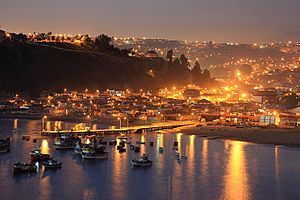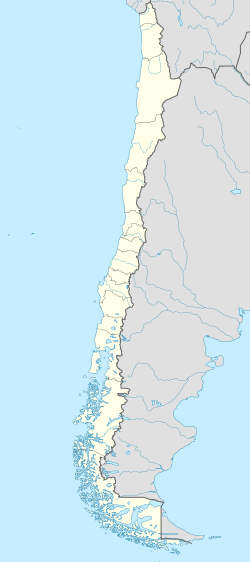Lota, Chile facts for kids
Quick facts for kids
Lota
|
|||||
|---|---|---|---|---|---|

Dusk in Lota
|
|||||
|
|||||
| Country | Chile | ||||
| Region | Biobío | ||||
| Province | Concepción | ||||
| Founded | 1662 | ||||
| Founded as | Santa María de Guadalupe | ||||
| Government | |||||
| • Type | Municipality | ||||
| Area | |||||
| • Total | 135.8 km2 (52.4 sq mi) | ||||
| Elevation | 82 m (269 ft) | ||||
| Population
(2012 Census)
|
|||||
| • Total | 47,339 | ||||
| • Density | 348.59/km2 (902.9/sq mi) | ||||
| • Urban | 48,975 | ||||
| • Rural | 114 | ||||
| Sex | |||||
| • Men | 23,944 | ||||
| • Women | 25,145 | ||||
| Time zone | UTC−4 (CLT) | ||||
| • Summer (DST) | UTC−3 (CLST) | ||||
| Area code(s) | 56 + 41 | ||||
| Website | Official website: http://www.lota.cl | ||||
Lota is a city and commune in central Chile. It's located on the Gulf of Arauco, a large bay. Lota is part of the Biobío Region, about 39 kilometers (24 miles) south of Concepción. It's famous for its history of coal mining, even though the mines closed in the 1990s.
Contents
History of Lota
The first Spanish settlement here was called Santa Maria de Guadalupe. It was started by Governor Ángel de Peredo on October 12, 1662. However, it didn't last long because of conflicts during the Arauco War.
The Rise of Coal Mining
The modern city of Lota grew because of the coal mining industry. This industry began in the 1800s. At first, the coal was easy to get because it was close to the ground. Coal mining became important when steamships started arriving at the port of Talcahuano. These ships, mostly from Britain, needed coal for fuel.
A businessman named Matías Cousiño started mining operations in Lota in 1852. Before this, Lota was a quiet border area. Coal mining changed it into a busy industrial center. Many people from all over Chile moved to Lota to work in the mines.
Lota officially became a town on January 5, 1875. It then became a city on November 30, 1881. The name Lota likely comes from the Mapudungun word Louta. This word means small piece of land.
Challenges and Changes
In 1960, miners and their families went on a general strike. They were asking for higher salaries. As they marched towards Concepción, a big earthquake, the 1960 Concepción earthquake, hit the area. This event ended the strike.
For much of the 1900s, Lota was a strong supporter of pro-Soviet communism. In 1971, Salvador Allende's government took control of the city's coal mines. The miners were happy about this change.
When Allende's government was overthrown, a military dictatorship took over. Political parties and strong trade unions in Lota were banned. People involved in these groups faced difficulties, and some were even harmed. Much of the local news was stopped because it was linked to unions or political groups.
End of an Era
In the late 1900s, Lota's coal industry began to struggle. Factories, ships, and trains, which used to buy a lot of coal, started using other types of energy. People had worried about Lota's economy depending too much on coal since the 1920s.
One problem was that it was hard to use machines in Lota's mines. The coal layers were thin and broken by many geological faults. Costs also went up because wooden supports for the mines became more expensive. Also, the easily reachable coal was gone, and mining had to be done under the sea.
The mines closed in the 1990s. This happened because there was less demand for Lota's coal. Also, cheaper coal from Colombia became available. This led to many people in Lota facing poverty. The final closure happened in 1997 when Empresa Nacional del Carbón shut down the mines. After that, the mines filled with water.
Lota Today
Now, tourism, forestry, artisan fishing, and small businesses provide jobs. It has been hard for older miners to learn new skills. Even though coal mining ended, the people of Lota still feel a strong connection to its mining past.
Places to Visit in Lota
Lota has several interesting places to explore:
- Playa de Colcura: A beautiful beach where you can relax.
- Chivilingo Hydroelectric Plant: One of the first hydroelectric power plants in Chile. It's a historic site.
- El Chiflón del Diablo: An old coal mine that is now a museum. You can go inside and learn about the miners' lives.
About Lota's Population
According to the 2002 census by the National Statistics Institute, Lota covers an area of 135.8 square kilometers (52.4 sq mi). It had 49,089 people living there. This included 23,944 men and 25,145 women.
Most of the people, about 48,975 (99.8%), lived in urban areas. Only 114 people (0.2%) lived in rural areas. The population decreased by 2.3% between the 1992 and 2002 censuses. By the late 2000s, the population dropped below 40,000. This means it had almost halved since the 1980s, when it was around 80,000.
How Lota is Governed
Lota is a commune, which is a local administrative area in Chile. It is managed by a municipal council. The council is led by an alcalde, who is like a mayor. The alcalde is chosen by the people every four years. From 2008 to 2012, the alcalde was Patricio Marchant Ulloa, from the PDC.
Lota is part of Chile's electoral system. It is represented in the Chamber of Deputies (one part of the Chilean parliament). It is also represented in the Senate (the other part of the parliament).
See also
 In Spanish: Lota para niños
In Spanish: Lota para niños




